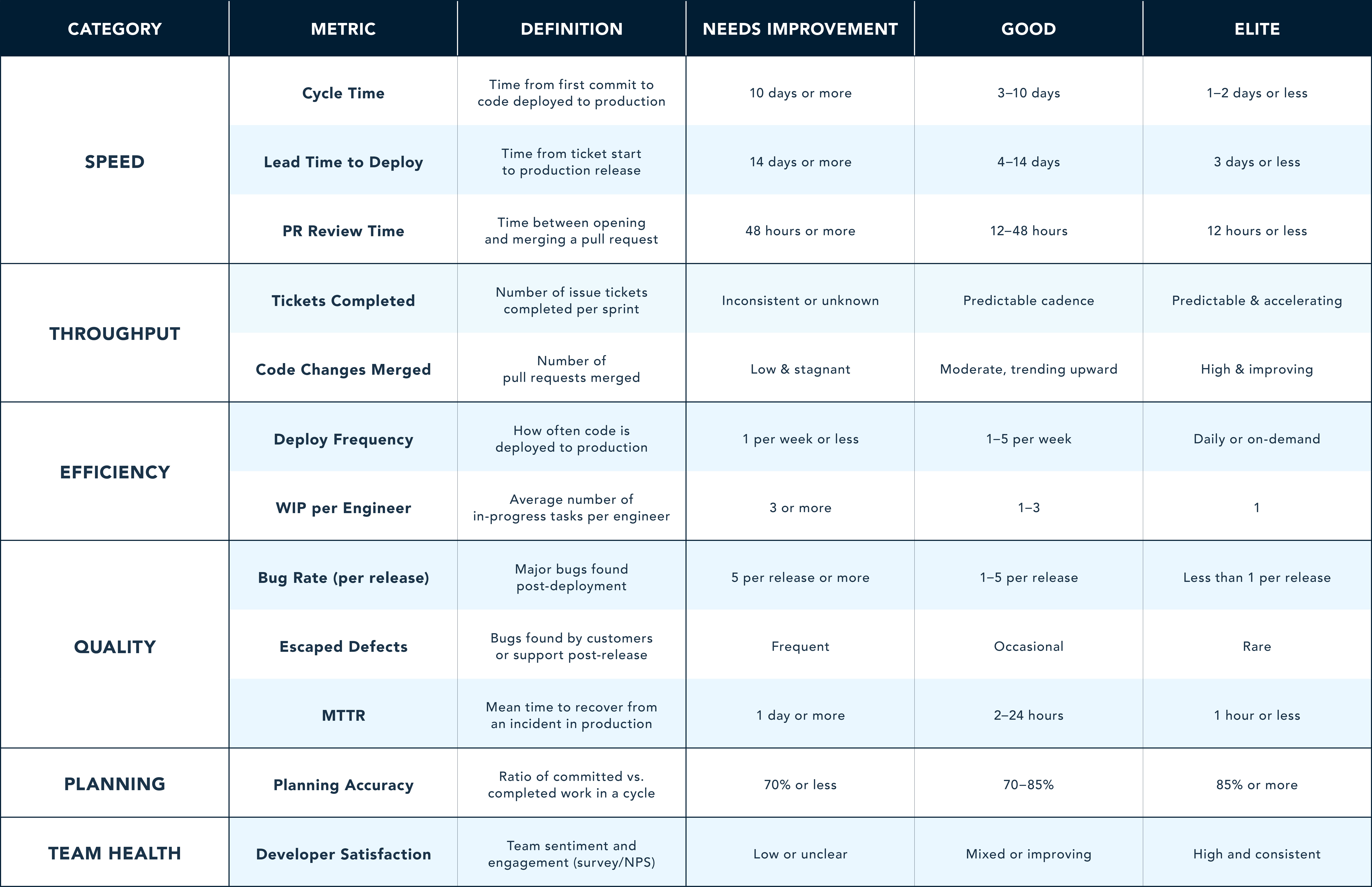I’ve worked with hundreds of software company CFOs, and almost every one will tell you R&D is one of—if not the—largest expense lines on their P&Ls. And yet, unlike sales or marketing, engineering productivity often goes unmeasured—treated as a black box rather than a business lever.
That’s a missed opportunity. As CFOs take on broader mandates around data, capital efficiency, and long-range planning, I believe engineering productivity belongs squarely within their remit. But measurement requires alignment. To get there, CFOs and CTOs must learn to speak each other’s language and build a shared framework for tracking what matters.
Here are four steps to get you started:
- Start with a common lexicon—and a shared commitment
It’s easy to analyze pipeline velocity or CAC payback. But what’s the engineering equivalent of these metrics? The answer varies depending on a company’s product maturity, development model and team structure. That’s why the goal isn’t a universal dashboard; it’s an evolving framework, co-developed by finance and engineering and grounded in trend-based tracking and continuous iteration. For example, in a company shipping weekly releases, it might make sense to measure deployment frequency and mean time to recovery (MTTR). In a company building a complex infrastructure product with longer development cycles, planning accuracy and cycle time might be more relevant metrics. A CFO doesn’t need to know what every pull request does. But they do need to understand how engineering is allocating resources, delivering value and responding to change. Moreover, CFOs can bring structure to the conversation: aligning metrics to investment theses, time horizons and business outcomes. - Build a consistent communication rhythm
We often ask CFOs when they last had a one-on-one with their CTO. The answer, more often than not: “It’s been a while. ”For CFOs, understanding engineering productivity isn’t about micro-management—it’s about visibility. Regular touchpoints, monthly or even quarterly, can help bridge the gap. These conversations shouldn’t just be about budgets or headcount. They should include discussions of development goals, challenges and how engineering output ties to strategic priorities. CFOs can help clarify what trade-offs the business is willing to make (e.g., time-to-market vs. technical debt), while CTOs can shed light on where additional investment would accelerate velocity or improve quality. When these conversations are grounded in data, they move from abstract to actionable. Of course, CFOs must also be thoughtful about how they approach these conversations. A common misstep is leading with budget scrutiny or requests for cost cuts, which can put technical leaders on the defensive. Instead, CFOs can frame their involvement as an opportunity to unlock more impact from engineering, not limit it. One powerful way to earn trust is by asking how finance can help remove friction, asking questions like “Where do we lose momentum?” or “Is there anywhere we’re underinvesting that’s slowing you down?” By showing genuine curiosity and offering operational leverage—whether that’s better forecasting, smarter capital allocation or tools to surface hidden bottlenecks—CFOs can become valued partners, not gatekeepers. - Choose metrics that evolve over time
Engineering productivity is multidimensional: There’s no single metric that captures it all. Instead of searching for the perfect KPIs, choose a handful that provide directional insight into throughput, speed, quality and team health. Start by asking: What are we trying to improve? Then align metrics accordingly. You don’t need to measure everything all at once. In fact, the most effective metrics programs start small, focusing on a few data points that help explain what’s working, what’s slowing things down and what’s improving over time. At the end of this post, I’ve included a sample table of commonly used engineering productivity metrics, complete with definitions and benchmarks, to help jumpstart those conversations. - Start with a spreadsheet—and scale from there
Don’t over-engineer the process. In the early days of this new collaboration, a shared spreadsheet or lightweight dashboard can go a long way towards building trust and visibility. The goal isn’t to launch a full-blown reporting suite overnight. It’s to establish a habit of reviewing and discussing metrics together on a regular cadence. As teams mature and the need for scale increases, purpose-built tools can dramatically improve the fidelity and timeliness of your metrics. For example, LinearB* provides real-time visibility into engineering performance with minimal setup. It integrates directly with your existing developer tools (e.g., Git, Jira) and automates reporting on metrics like cycle time, deploy frequency and code churn—helping teams identify inefficiencies, reduce bottlenecks and accelerate delivery. Tools like this help transform engineering conversations from anecdotal to analytical—and make it easier for both finance and engineering leaders to work from a shared source of truth.
Final thoughts: Align on the why
Ultimately, engineering is one of the largest, most complex and least understood cost centers in modern software businesses. CFOs and CTOs who align early—on goals, language and metrics—are far better positioned to optimize both investment and impact.
Remember, this isn’t just about improving margins. It’s about staying competitive, delivering value to customers faster and positioning R&D as a strategic advantage. When finance and engineering collaborate, the result isn’t just better measurement, it’s better business.
Appendix: Engineering Productivity Metrics – Definitions & Benchmarks
CFOs can use the table below to familiarize themselves with common engineering metrics. Don’t think of these as rigid KPIs–they’re more directional benchmarks to help CFOs and CTOs start speaking the same language, ask better questions, spot patterns and make smarter trade-offs together.

The information contained here is based solely on the opinion of Alex Auchter, and nothing should be construed as investment advice. This material is provided for informational purposes, and it is not, and may not be relied on in any manner as legal, tax or investment advice or as an offer to sell or a solicitation of an offer to buy an interest in any fund or investment vehicle managed by Battery Ventures or any other Battery entity. The views expressed here are solely those of the author.
*Denotes a Battery portfolio company. For a full list of all Battery investments and exits, please click here.
The information above may contain projections or other forward-looking statements regarding future events or expectations. Predictions, opinions and other information discussed in this publication are subject to change continually and without notice of any kind and may no longer be true after the date indicated. Battery Ventures assumes no duty to and does not undertake to update forward-looking statements.


A monthly newsletter to share new ideas, insights and introductions to help entrepreneurs grow their businesses.





